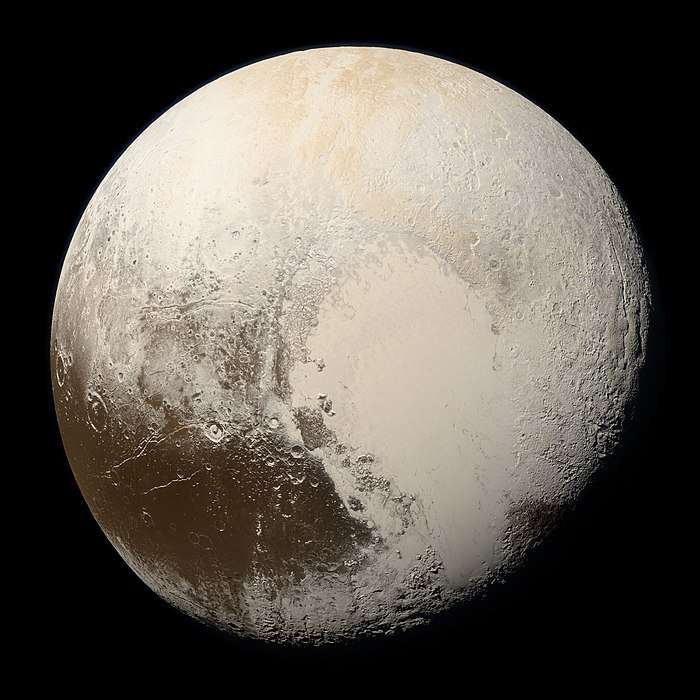471143 Dziewanna
471143 Dziewanna /dʒɪˈvænə/, provisional designation 2010 EK139, is a trans-Neptunian object in the scattered disc, orbiting the Sun in the outermost region of the Solar System.
 Dziewanna imaged by the Hubble Space Telescope in 2012 | |
| Discovery [1][2] | |
|---|---|
| Discovered by | A. Udalski S. S. Sheppard M. Kubiak C. Trujillo |
| Discovery site | Las Campañas Obs. |
| Discovery date | 13 March 2010 |
| Designations | |
| (471143) Dziewanna | |
| Pronunciation | /dʒɪˈvænə/ |
Named after | Devana (Dziewanna) (Slavic goddes)[1] |
| 2010 EK139 | |
| TNO [3] · SDO · 2:7 [4] | |
| Adjectives | Dziewannian |
| Orbital characteristics [3] | |
| Epoch 23 March 2018 (JD 2458200.5) | |
| Uncertainty parameter 3 | |
| Observation arc | 13.16 yr (4,808 d) |
| Aphelion | 108.54 AU |
| Perihelion | 32.551 AU |
| 70.544 AU | |
| Eccentricity | 0.5386 |
| 592.51 yr (216,416 d) | |
| 347.58° | |
| 0° 0m 6.12s / day | |
| Inclination | 29.444° |
| 346.15° | |
| 284.25° | |
| Known satellites | none[5] |
| Physical characteristics | |
Mean diameter | 470+35 −10 km[5] 697 km[6] |
| 7.07±0.05[7] | |
| 0.10 (assumed)[6] 0.25+0.02 −0.05[5] | |
| 19.6 (R)[4] 19.9[8] | |
| 3.8±0.1[5] 3.89±0.04 (S)[7] 3.9[1][3] | |
It was discovered on 13 March 2010, by astronomers Andrzej Udalski, Scott Sheppard, Marcin Kubiak and Chad Trujillo at the Las Campañas Observatory in Chile.[1] The discovery was made during the Polish OGLE project of Warsaw University.[9] Based on its absolute magnitude and assumed albedo, it is possibly a dwarf planet[10] with a calculated diameter of approximately 470 kilometers.[5]
It was named after Devana (Polish form: Dziewanna), a Slavic goddess of the wilderness, forests and the hunt.[1]
Distance


The minor planet orbits the Sun at a distance of 32.6–108.3 AU once every 591 years and 4 months (215,992 days). Its orbit has an eccentricity of 0.54 and an inclination of 29° with respect to the ecliptic.[3]
It is currently 39.1 AU from the Sun and will reach perihelion in 2038.[3][8] A ten-million-year integration of the orbit shows that this object is in a 2:7 resonance with Neptune.[4]
A first precovery was taken by the Near-Earth Asteroid Tracking at Palomar Observatory in 2002, extending the minor planet's observation arc by 8 years prior to its discovery observation. Since then it has been observed 143 times over 6 oppositions and has an orbit quality of 1.[1]
Physical properties
In 2010, the thermal radiation of Dziewanna was observed by the Herschel Space Telescope, which allowed astronomers to estimate its diameter at about 470 kilometres (290 mi).[5]
Published in May 2013, a rotational lightcurve for this minor planet was obtained from photometric observations at the discovering observatory with the 2.5-meter Irénée du Pont Telescope. It gave a rotation period of 7.07±0.05 hours with a brightness variation of 0.12 magnitude (U=2).[7]
Observations by American astronomer Michael Brown, using the Keck telescope in March 2012, suggest that there is no satellite, and therefore no immediate means to determine its mass.[5]
References
- "471143 Dziewanna (2010 EK139)". Minor Planet Center. Retrieved 5 October 2018.
- "MPEC 2010-G49 : 2010 EK139". IAU Minor Planet Center. 2010-04-08. Retrieved 2010-12-03.
- "JPL Small-Body Database Browser: 471143 Dziewanna (2010 EK139)" (2015-05-14 last obs.). Jet Propulsion Laboratory. Retrieved 5 October 2018.
- Marc W. Buie. "Orbit Fit and Astrometric record for 10EK139" (2010-04-09 using 32 of 32 observations). SwRI (Space Science Department). Archived from the original on 2011-06-22. Retrieved 2010-12-02.
- Pál, A.; Kiss, C.; Müller, T. G.; Santos-Sanz, P.; Vilenius, E.; Szalai, N.; et al. (May 2012). ""TNOs are Cool": A survey of the trans-Neptunian region. VII. Size and surface characteristics of (90377) Sedna and 2010 EK139". Astronomy and Astrophysics. 541: 4. arXiv:1204.0899. Bibcode:2012A&A...541L...6P. doi:10.1051/0004-6361/201218874.
- "LCDB Data for (471143)". Asteroid Lightcurve Database (LCDB). Retrieved 21 September 2016.
- Benecchi, Susan D.; Sheppard, Scott S. (May 2013). "Light Curves of 32 Large Transneptunian Objects". The Astronomical Journal. 145 (5): 19. arXiv:1301.5791. Bibcode:2013AJ....145..124B. doi:10.1088/0004-6256/145/5/124.
- "AstDys 2010EK139 Ephemerides". Department of Mathematics, University of Pisa, Italy. Retrieved 2010-12-11.
- Krzysztof Urbański (4 May 2010). "Układ Słoneczny coraz większy". Rzeczpospolita. Retrieved 4 May 2010. (English translation)
- Michael E. Brown. "How many dwarf planets are there in the outer solar system? (updates daily)". California Institute of Technology. Retrieved 20 September 2016.
- Lowe, Andrew. "(471143) 2010 EK139 Precovery Images". andrew-lowe.ca.
External links
- MPEC 2010 G50 : 2010 EK139, Minor Planet Electronic Circular, issued on 8 April 2010
- OCKS: OGLE Carnegie Kuiper belt Survey (OCKS is a Southern sky survey searching for Kuiper-belt objects and dwarf planets)
- List Of Centaurs and Scattered-Disk Objects, Minor Planet Center
- 471143 Dziewanna at the JPL Small-Body Database
_(cropped).jpg)
